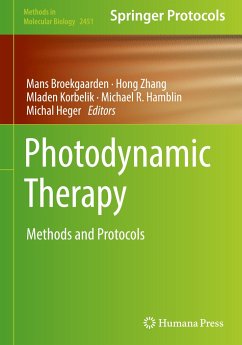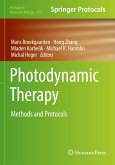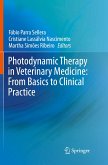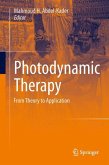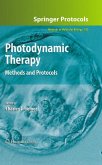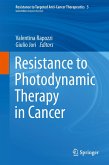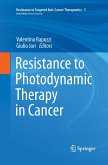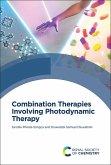Photodynamic Therapy
Methods and Protocols
Herausgegeben:Broekgaarden, Mans; Zhang, Hong; Korbelik, Mladen; Hamblin, Michael R.; Heger, Michal
Photodynamic Therapy
Methods and Protocols
Herausgegeben:Broekgaarden, Mans; Zhang, Hong; Korbelik, Mladen; Hamblin, Michael R.; Heger, Michal
- Gebundenes Buch
- Merkliste
- Auf die Merkliste
- Bewerten Bewerten
- Teilen
- Produkt teilen
- Produkterinnerung
- Produkterinnerung
This collection explores state-of-the-art methods and protocols for research on photodynamic therapy (PDT) and its use in a wide range of medical applications, from antiviral to anticancer. Beginning with an extensive section on in vitro and in vivo models, the volume continues with chapters on oxygen-independent photosensitizers, next-generation photosensitization strategies, contemporary insights into the immunomodulatory effects of PDT, antimicrobial effects of PDT, as well as a variety of general biochemical and molecular biological techniques. Written for the highly successful Methods in…mehr
Andere Kunden interessierten sich auch für
![Photodynamic Therapy Photodynamic Therapy]() Photodynamic Therapy169,99 €
Photodynamic Therapy169,99 €![Photodynamic Therapy in Veterinary Medicine: From Basics to Clinical Practice Photodynamic Therapy in Veterinary Medicine: From Basics to Clinical Practice]() Photodynamic Therapy in Veterinary Medicine: From Basics to Clinical Practice86,99 €
Photodynamic Therapy in Veterinary Medicine: From Basics to Clinical Practice86,99 €![Photodynamic Therapy Photodynamic Therapy]() Photodynamic Therapy112,99 €
Photodynamic Therapy112,99 €![Photodynamic Therapy Photodynamic Therapy]() Photodynamic Therapy75,99 €
Photodynamic Therapy75,99 €![Resistance to Photodynamic Therapy in Cancer Resistance to Photodynamic Therapy in Cancer]() Resistance to Photodynamic Therapy in Cancer75,99 €
Resistance to Photodynamic Therapy in Cancer75,99 €![Resistance to Photodynamic Therapy in Cancer Resistance to Photodynamic Therapy in Cancer]() Resistance to Photodynamic Therapy in Cancer75,99 €
Resistance to Photodynamic Therapy in Cancer75,99 €![Combination Therapies Involving Photodynamic Therapy Combination Therapies Involving Photodynamic Therapy]() Oluwatobi Samuel OluwafemiCombination Therapies Involving Photodynamic Therapy246,99 €
Oluwatobi Samuel OluwafemiCombination Therapies Involving Photodynamic Therapy246,99 €-
-
-
This collection explores state-of-the-art methods and protocols for research on photodynamic therapy (PDT) and its use in a wide range of medical applications, from antiviral to anticancer. Beginning with an extensive section on in vitro and in vivo models, the volume continues with chapters on oxygen-independent photosensitizers, next-generation photosensitization strategies, contemporary insights into the immunomodulatory effects of PDT, antimicrobial effects of PDT, as well as a variety of general biochemical and molecular biological techniques. Written for the highly successful Methods in Molecular Biology series, chapters include the kind of detailed implementation advice that ensures successful results in the lab.
Thorough and authoritative, Photodynamic Therapy: Methods and Protocols serves as an ideal source of inspiration for both new and established PDT scientists and a guide for designing innovative research programs in this continuously advancing and multidisciplinary field.
Thorough and authoritative, Photodynamic Therapy: Methods and Protocols serves as an ideal source of inspiration for both new and established PDT scientists and a guide for designing innovative research programs in this continuously advancing and multidisciplinary field.
Produktdetails
- Produktdetails
- Methods in Molecular Biology 2451
- Verlag: Humana / Springer US / Springer, Berlin
- Artikelnr. des Verlages: 978-1-0716-2098-4
- 1st edition 2022
- Seitenzahl: 768
- Erscheinungstermin: 4. Mai 2022
- Englisch
- Abmessung: 260mm x 183mm x 47mm
- Gewicht: 1615g
- ISBN-13: 9781071620984
- ISBN-10: 1071620983
- Artikelnr.: 62588839
- Herstellerkennzeichnung Die Herstellerinformationen sind derzeit nicht verfügbar.
- Methods in Molecular Biology 2451
- Verlag: Humana / Springer US / Springer, Berlin
- Artikelnr. des Verlages: 978-1-0716-2098-4
- 1st edition 2022
- Seitenzahl: 768
- Erscheinungstermin: 4. Mai 2022
- Englisch
- Abmessung: 260mm x 183mm x 47mm
- Gewicht: 1615g
- ISBN-13: 9781071620984
- ISBN-10: 1071620983
- Artikelnr.: 62588839
- Herstellerkennzeichnung Die Herstellerinformationen sind derzeit nicht verfügbar.
Application of Monolayer Cell Cultures for Investigating Basic Mechanisms of Photodynamic Therapy.- The Negative Impact of Cancer Cell Nitric Oxide on Photodynamic Therapy.- Microtumor Models as a Preclinical Investigational Platform for Photodynamic Therapy.- A Microfluidic Model to Evaluate Photodynamic Therapy Treatment Response in 3D Tumors.- Analysis of Treatment Effects on Structurally Complex Microtumor Cultures Using a Comprehensive Image Analysis Procedure.- High-Throughput Examination of Therapy-Induced Alterations in Redox Metabolism in Spheroid and Microtumor Models.- Spatiotemporal Tracking of Different Cell Populations in Cancer Organoid Models for Investigations on Photodynamic Therapy.- Generating Large Numbers of Pancreatic Microtumors on Alginate-Gelatin Hydrogels for Quantitative Imaging of Tumor Growth and Photodynamic Therapy Optimization.- The Chicken Embryo Chorioallantoic Membrane as an In Vivo Model for Photodynamic Therapy.- Subcutaneous Xenograft Models for Studying PDT In Vivo.- In Vivo Models for Studying Interstitial Photodynamic Therapy of Locally Advanced Cancer.- Orthotopic Models of Pancreatic Cancer to Study PDT.- An Orthotopic Murine Model of Peritoneal Carcinomatosis of Ovarian Origin for Intraoperative PDT.- Photodynamic Treatments for Disseminated Cancer Metastases Using Fiber-Optic Technologies.- Stereotaxic Implantation of F98 Cells in Fischer Rats: A Syngeneic Model to Investigate Photodynamic Therapy Response in Glioma.- New Generation of Photosensitizers Based on Inorganic Nanomaterials.- Cytotoxicity of Metal-Based Photoactivated Chemotherapy (PACT) Compounds.- Photosensitized Oxidation of Intracellular Targets: Understanding the Mechanisms to Improve the Efficiency of Photodynamic Therapy.- Inhibition of the HIF-1 Survival Pathway as a Strategy to Augment Photodynamic Therapy Efficacy.- Strategies for Improving Photodynamic Therapy through Pharmacological Modulation of the Immediate Early Stress Response.- Nanobody-Targeted Photodynamic Therapy: Nanobody Production and Purification.- Conjugation of IRDye Photosensitizers or Fluorophores to Nanobodies.- In Vitro Assessment of Binding Affinity, Selectivity, Uptake, Intracellular Degradation, and Toxicity of Nanobody-Photosensitizer Conjugates.- Assessment of the In Vivo Response to Nanobody-Targeted PDT through Intravital Microscopy.- Orthotopic Breast Cancer Model to Investigate the Therapeutic Efficacy of Nanobody-Targeted Photodynamic Therapy.- Investigation of the Therapeutic Potential of Nanobody-Targeted Photodynamic Therapy in an Orthotopic Head and Neck Cancer Model.- Evaluation of the Antitumor Immune Response Following Photofrin-Based PDT in Combination with the Epigenetic Agent 5-Aza-2'-Deoxycytidine.- Controlling Immunoregulatory Cell Activity for Effective Photodynamic Therapy of Cancer.- Measuring the Anti-Tumor T-Cell Response in the Context of Photodynamic Therapy.- Combination of Photodynamic Therapy and Immune Checkpoint Blockade.- Combination of Photodynamic Therapy and Therapeutic Vaccination.- In Vitro Potentiation of Antimicrobial Photodynamic Inactivation by Addition of Potassium Iodide.- In Vivo Potentiation of Antimicrobial Photodynamic Therapy in a Mouse Model of Fungal Infection by Addition of Potassium Iodide.- Bioluminescent Models to Evaluate the Efficiency of Light-Based Antibacterial Approaches.- Photochemical Internalization as a New Strategy to Enhance Efficacy of Antimicrobial Agents against Intracellular Infections.- Determination of the Efficiency of Photodynamic Decontamination of Food.- Super-Resolution Imaging of Intracellular Lipid Nanocarriers to Study Drug Delivery in Photodynamic Therapy.- Detection of Paraptosis after Photodynamic Therapy.- Optimal Use of 2´,7´-Dichlorofluorescein Diacetate in Cultured Hepatocytes.
Application of Monolayer Cell Cultures for Investigating Basic Mechanisms of Photodynamic Therapy.- The Negative Impact of Cancer Cell Nitric Oxide on Photodynamic Therapy.- Microtumor Models as a Preclinical Investigational Platform for Photodynamic Therapy.- A Microfluidic Model to Evaluate Photodynamic Therapy Treatment Response in 3D Tumors.- Analysis of Treatment Effects on Structurally Complex Microtumor Cultures Using a Comprehensive Image Analysis Procedure.- High-Throughput Examination of Therapy-Induced Alterations in Redox Metabolism in Spheroid and Microtumor Models.- Spatiotemporal Tracking of Different Cell Populations in Cancer Organoid Models for Investigations on Photodynamic Therapy.- Generating Large Numbers of Pancreatic Microtumors on Alginate-Gelatin Hydrogels for Quantitative Imaging of Tumor Growth and Photodynamic Therapy Optimization.- The Chicken Embryo Chorioallantoic Membrane as an In Vivo Model for Photodynamic Therapy.- Subcutaneous Xenograft Models for Studying PDT In Vivo.- In Vivo Models for Studying Interstitial Photodynamic Therapy of Locally Advanced Cancer.- Orthotopic Models of Pancreatic Cancer to Study PDT.- An Orthotopic Murine Model of Peritoneal Carcinomatosis of Ovarian Origin for Intraoperative PDT.- Photodynamic Treatments for Disseminated Cancer Metastases Using Fiber-Optic Technologies.- Stereotaxic Implantation of F98 Cells in Fischer Rats: A Syngeneic Model to Investigate Photodynamic Therapy Response in Glioma.- New Generation of Photosensitizers Based on Inorganic Nanomaterials.- Cytotoxicity of Metal-Based Photoactivated Chemotherapy (PACT) Compounds.- Photosensitized Oxidation of Intracellular Targets: Understanding the Mechanisms to Improve the Efficiency of Photodynamic Therapy.- Inhibition of the HIF-1 Survival Pathway as a Strategy to Augment Photodynamic Therapy Efficacy.- Strategies for Improving Photodynamic Therapy through Pharmacological Modulation of the Immediate Early Stress Response.- Nanobody-Targeted Photodynamic Therapy: Nanobody Production and Purification.- Conjugation of IRDye Photosensitizers or Fluorophores to Nanobodies.- In Vitro Assessment of Binding Affinity, Selectivity, Uptake, Intracellular Degradation, and Toxicity of Nanobody-Photosensitizer Conjugates.- Assessment of the In Vivo Response to Nanobody-Targeted PDT through Intravital Microscopy.- Orthotopic Breast Cancer Model to Investigate the Therapeutic Efficacy of Nanobody-Targeted Photodynamic Therapy.- Investigation of the Therapeutic Potential of Nanobody-Targeted Photodynamic Therapy in an Orthotopic Head and Neck Cancer Model.- Evaluation of the Antitumor Immune Response Following Photofrin-Based PDT in Combination with the Epigenetic Agent 5-Aza-2'-Deoxycytidine.- Controlling Immunoregulatory Cell Activity for Effective Photodynamic Therapy of Cancer.- Measuring the Anti-Tumor T-Cell Response in the Context of Photodynamic Therapy.- Combination of Photodynamic Therapy and Immune Checkpoint Blockade.- Combination of Photodynamic Therapy and Therapeutic Vaccination.- In Vitro Potentiation of Antimicrobial Photodynamic Inactivation by Addition of Potassium Iodide.- In Vivo Potentiation of Antimicrobial Photodynamic Therapy in a Mouse Model of Fungal Infection by Addition of Potassium Iodide.- Bioluminescent Models to Evaluate the Efficiency of Light-Based Antibacterial Approaches.- Photochemical Internalization as a New Strategy to Enhance Efficacy of Antimicrobial Agents against Intracellular Infections.- Determination of the Efficiency of Photodynamic Decontamination of Food.- Super-Resolution Imaging of Intracellular Lipid Nanocarriers to Study Drug Delivery in Photodynamic Therapy.- Detection of Paraptosis after Photodynamic Therapy.- Optimal Use of 2´,7´-Dichlorofluorescein Diacetate in Cultured Hepatocytes.

